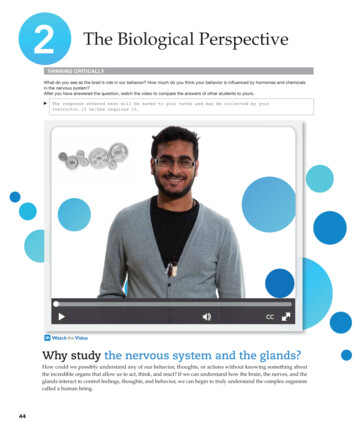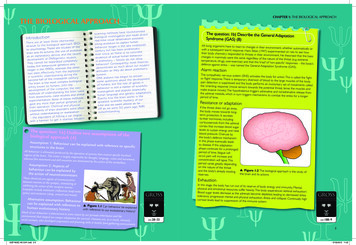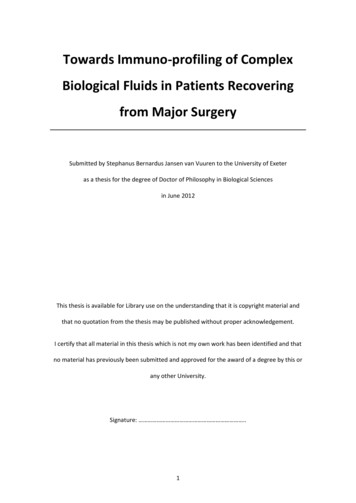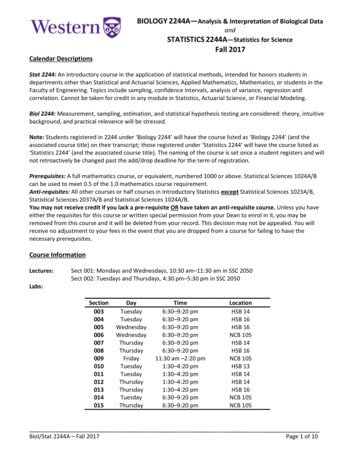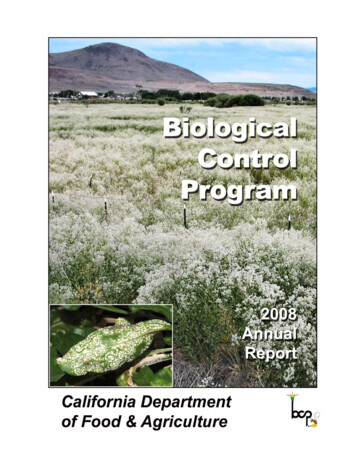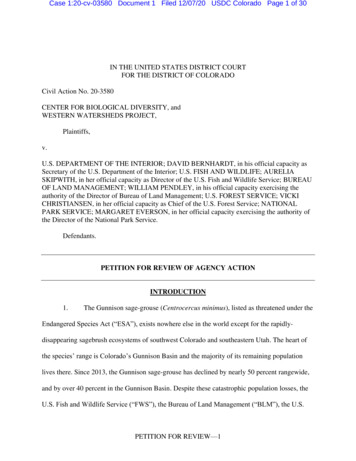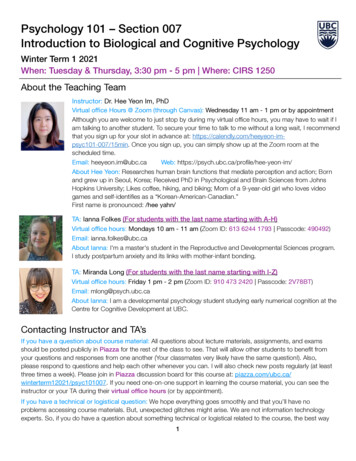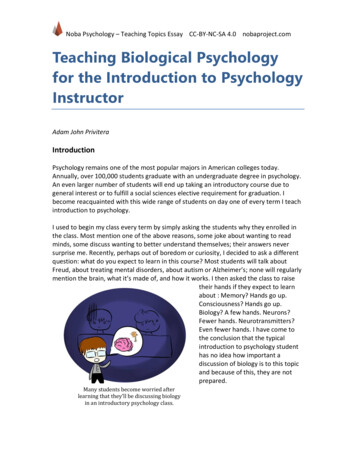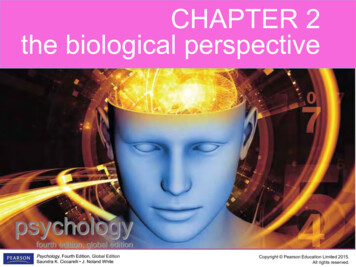
Transcription
CHAPTER 2the biological perspectivepsychologyfourth edition, global editionPsychology, Fourth EditionEdition, Global EditionSaundra K. Ciccarelli J. Noland WhiteCopyright Pearson Education Limited 2015.All rights reserved.
Overview of Nervous SystemLO 2.1 What Are the Nervous System, Neurons, and Nerves? Biological Psychology– focuses on the biological bases ofpsychological processes, behavior,and learning Nervous system– an extensive network of specializedcells that carry information to and fromall parts of the bodyPsychology, Fourth EditionEdition, Global EditionSaundra K. Ciccarelli J. Noland WhiteCopyright Pearson Education Limited 2015.All rights reserved.
Structure of the NeuronLO 2.1 What Are the Nervous System, Neurons, and Nerves?Neuron is the basic cell that makes up the nervous system receives and sends messages within the nervous systemFigure 2.2 The Structure of the NeuronThe electronmicrograph on the left shows myelinated axons.Psychology, Fourth EditionEdition, Global EditionSaundra K. Ciccarelli J. Noland WhiteCopyright Pearson Education Limited 2015.All rights reserved.
Structure of the NeuronLO 2.1 What Are the Nervous System, Neurons, and Nerves?Parts of a neuron1. Soma: the cell body of the neuron responsible for maintaining the life of the cellFigure 2.2 The Structure of the NeuronThe electronmicrograph on the left shows myelinated axons.Psychology, Fourth EditionEdition, Global EditionSaundra K. Ciccarelli J. Noland WhiteCopyright Pearson Education Limited 2015.All rights reserved.
Structure of the NeuronLO 2.1 What Are the Nervous System, Neurons, and Nerves?Parts of a neuron2. Dendrites: branch-like structures that receive messages fromother neurons3. Axon: long, tube-like structure that sends messages to othercellsFigure 2.2 The Structure of the NeuronThe electronmicrograph on the left shows myelinated axons.Psychology, Fourth EditionEdition, Global EditionSaundra K. Ciccarelli J. Noland WhiteCopyright Pearson Education Limited 2015.All rights reserved.
Other Types of Brain CellsLO 2.1 What Are the Nervous System, Neurons, and Nerves? Glial cells are fatty cells that:– provide support for the neurons to grow on– deliver nutrients to neurons– produce myelin to coat axonsPsychology, Fourth EditionEdition, Global EditionSaundra K. Ciccarelli J. Noland WhiteCopyright Pearson Education Limited 2015.All rights reserved.
Other Types of Brain CellsLO 2.1 What Are the Nervous System, Neurons, and Nerves?Myelin: fatty substances produced by certainglial cells coat the axons to insulate, protect, andspeed up the neural impulse– Nerve impulse is the electricalmessage that is transmitted down theaxon of a neuronPsychology, Fourth EditionEdition, Global EditionSaundra K. Ciccarelli J. Noland WhiteCopyright Pearson Education Limited 2015.All rights reserved.
Generating the Message: Neural ImpulseLO 2.1 What Are the Nervous System, Neurons, and Nerves? Ions: charged particles located inside and outside of the cell– inside neuron: negatively charged– outside neuron: positively charged– Difference in charges creates an electrical potential Resting potential: the state of the neuron when not firing aneural impulsePsychology, Fourth EditionEdition, Global EditionSaundra K. Ciccarelli J. Noland WhiteCopyright Pearson Education Limited 2015.All rights reserved.
Generating the Message: Neural ImpulseLO 2.1 What Are the Nervous System, Neurons, and Nerves?Action potential: occurs when there is a release of the neural impulse allows positive sodium ions to enter the cell consists of a reversal of the electrical charge within the axonAll-or-none law: a neuron either fires completely or does not fire at allPsychology, Fourth EditionEdition, Global EditionSaundra K. Ciccarelli J. Noland WhiteCopyright Pearson Education Limited 2015.All rights reserved.
Generating the Message: Neural ImpulseLO 2.1 What Are the Nervous System, Neurons, and Nerves? Hyperpolarization occurs when the negative charge inside the axonincreases (e.g., -70 mV becomes -80 mV) Return to resting potentialPsychology, Fourth EditionEdition, Global EditionSaundra K. Ciccarelli J. Noland WhiteCopyright Pearson Education Limited 2015.All rights reserved.
Communication Between NeuronsLO 2.2 How Neurons Use Neurotransmitters to Communicate Sending the message to other cells Axon terminals:– rounded areas at the end of the branches at the end of the axon– responsible for communicating with other nerve cellsPsychology, Fourth EditionEdition, Global EditionSaundra K. Ciccarelli J. Noland WhiteCopyright Pearson Education Limited 2015.All rights reserved.
Communication Between NeuronsLO 2.2 How Neurons Use Neurotransmitters to Communicate Synaptic vesicles: sack-like structures found inside the axonterminal containing chemicals– Neurotransmitter: chemical found in the synaptic vesicleswhich, when released, has an effect on the next cellPsychology, Fourth EditionEdition, Global EditionSaundra K. Ciccarelli J. Noland WhiteCopyright Pearson Education Limited 2015.All rights reserved.
Neuron CommunicationLO 2.2 How Neurons Use Neurotransmitters to Communicate Excitatory neurotransmitter: neurotransmitter that causes thereceiving cell to fire Inhibitory neurotransmitter: neurotransmitter that causes thereceiving cell to stop firingPsychology, Fourth EditionEdition, Global EditionSaundra K. Ciccarelli J. Noland WhiteCopyright Pearson Education Limited 2015.All rights reserved.
Communication Between NeuronsLO 2.2 How Neurons Use Neurotransmitters to Communicate Synapse/synaptic gap: fluid-filled space between “the rounded areason the end of the axon terminals of one cell” and (2) “the dendrites orsurface of the next cell” Receptor sites: holes in the surface of the dendrites or certain cells– shaped to fit only certain neurotransmittersPsychology, Fourth EditionEdition, Global EditionSaundra K. Ciccarelli J. Noland WhiteCopyright Pearson Education Limited 2015.All rights reserved.
Cleaning up the SynapseLO 2.2 How Neurons Use Neurotransmitters to Communicate Reuptake: process by which neurotransmitters aretaken back into the synaptic vesicles– Transporters are special membrane proteins that facilitatereuptakePsychology, Fourth EditionEdition, Global EditionSaundra K. Ciccarelli J. Noland WhiteCopyright Pearson Education Limited 2015.All rights reserved.
Figure 2.5 An Overview of the Nervous SystemPsychology, Fourth EditionEdition, Global EditionSaundra K. Ciccarelli J. Noland WhiteCopyright Pearson Education Limited 2015.All rights reserved.
Central Nervous System (CNS)LO 2.3 How the Brain and Spinal Cord InteractCNS: part of the nervous systemconsisting of the brain and spinalcordSpinal cord: a long bundle ofneurons that carries messages toand from the body to the brainthat is responsible for very fast,lifesaving reflexesPsychology, Fourth EditionEdition, Global EditionSaundra K. Ciccarelli J. Noland WhiteCopyright Pearson Education Limited 2015.All rights reserved.
The Reflex Arc: Three Types of NeuronsLO 2.3 How the Brain and Spinal Cord Interact1. Sensory neuron: carries information from the senses to the CNS– also called an afferent neuron2. Motor neuron: carries messages from CNS to the muscles of the body– also called an efferent neuronPsychology, Fourth EditionEdition, Global EditionSaundra K. Ciccarelli J. Noland WhiteCopyright Pearson Education Limited 2015.All rights reserved.
The Reflex Arc: Three Types of NeuronsLO 2.3 How the Brain and Spinal Cord Interact1. Sensory neuron: carries information from the senses to the CNS– also called an afferent neuron2. Motor neuron: carries messages from CNS to the muscles of the body– also called an efferent neuronPsychology, Fourth EditionEdition, Global EditionSaundra K. Ciccarelli J. Noland WhiteCopyright Pearson Education Limited 2015.All rights reserved.
The Reflex Arc: Three Types of NeuronsLO 2.3 How the Brain and Spinal Cord Interact3.Interneuron: a neuron found in the center of the spinal cord thatreceives information from the sensory neurons and sendscommands to the muscles through the motor neuronsPsychology, Fourth EditionEdition, Global EditionSaundra K. Ciccarelli J. Noland WhiteCopyright Pearson Education Limited 2015.All rights reserved.
Peripheral Nervous System (PNS)LO 2.4 Somatic and Autonomic Nervous SystemsPNS: all nerves and neurons that are not contained in thebrain and spinal cord but that run through the body itself divided into the:1. Somatic nervous system2. Autonomic nervous systemPsychology, Fourth EditionEdition, Global EditionSaundra K. Ciccarelli J. Noland WhiteCopyright Pearson Education Limited 2015.All rights reserved.
Somatic Nervous SystemLO 2.4 Somatic and Autonomic Nervous Systems Somatic nervous system:– consists of nerves that carryinformation from the senses to theCNS and from the CNS to thevoluntary muscles of the body Autonomic nervous system:– consists of nerves that control all ofthe involuntary muscles, organs, andglandsPsychology, Fourth EditionEdition, Global EditionSaundra K. Ciccarelli J. Noland WhiteCopyright Pearson Education Limited 2015.All rights reserved.
Autonomic Nervous SystemLO 2.4 Somatic and Autonomic Nervous SystemsSympathetic division (fight-or-flight system): responsible for reactingto stressful events and bodily arousalParasympathetic division: restores the body to normal functioningafter arousal and is responsible for the day-to-day functioning of theorgans and glandsPsychology, Fourth EditionEdition, Global EditionSaundra K. Ciccarelli J. Noland WhiteCopyright Pearson Education Limited 2015.All rights reserved.
How Hormones Interact with the Nervous Systemand Affect BehaviorLO 2.5 Endocrine Glands Endocrine glands: glands that secrete chemicals called hormonesdirectly into the bloodstream1. Pituitary gland (腦下垂體): located in the brain secretes human growth hormone influences all other hormone-secretingglands also known as the master glandFigure 2.9 The endocrine glandssecrete hormones directly into thebloodstream, which carries them toorgans in the body, such as the heart,pancreas, and sex organs.Psychology, Fourth EditionEdition, Global EditionSaundra K. Ciccarelli J. Noland WhiteFigure 2.9The Endocrine GlandsCopyright Pearson Education Limited 2015.All rights reserved.
How Hormones Interact with the Nervous Systemand Affect BehaviorLO 2.5 Endocrine Glands2. Pineal gland (松果體): secretes melatonin3. Thyroid gland (甲狀腺): regulatesmetabolism4. Pancreas (胰臟): controls the levels ofsugar in the blood5. Gonads (生殖腺): the sex glands;secrete hormones that regulate sexualdevelopment and behavior as well asreproduction ovaries and testes6. Adrenal gland (腎上腺): secretehormones to deal with stress; regulatesalt intake; provide a secondary sourceof sex hormones affecting the sexualchanges that occur during adolescencePsychology, Fourth EditionEdition, Global EditionSaundra K. Ciccarelli J. Noland WhiteFigure 2.9The Endocrine GlandsCopyright Pearson Education Limited 2015.All rights reserved.
Figure 2.12 Major Structures of the Human BrainPsychology, Fourth EditionEdition, Global EditionSaundra K. Ciccarelli J. Noland WhiteCopyright Pearson Education Limited 2015.All rights reserved.
The HindbrainLO 2.7 Structures and Functions of the Bottom Part of Brain1. Medulla: first large swelling at the top of the spinal cord, forming thelowest part of the brain– responsible for life-sustaining functions such as breathing, swallowing,and heart rate2. Pons: larger swelling above the medulla that connects the top of the brainto the bottom– plays a part in sleep, dreaming, left–right body coordination, andarousalPsychology, Fourth EditionEdition, Global EditionSaundra K. Ciccarelli J. Noland WhiteCopyright Pearson Education Limited 2015.All rights reserved.
The HindbrainLO 2.7 Structures and Functions of the Bottom Part of Brain3. Reticular formation: area of neurons running through the middle of themedulla and the pons and slightly beyond– responsible for selective attention4. Cerebellum: part of the lower brain located behind the pons– controls and coordinates involuntary, rapid, fine motor movementPsychology, Fourth EditionEdition, Global EditionSaundra K. Ciccarelli J. Noland WhiteCopyright Pearson Education Limited 2015.All rights reserved.
CortexLO 2.9 Parts of Cortex Controlling Senses and Movement Cortex 腦皮層: outermost covering of the brain; consists of denselypacked neurons on the outer surface of the cerebral hemispheres– responsible for higher thought processes and interpretation ofsensory input– divided into four lobes: occipital, parietal, temporal, and frontalPsychology, Fourth EditionEdition, Global EditionSaundra K. Ciccarelli J. Noland WhiteCopyright Pearson Education Limited 2015.All rights reserved.
Cerebral HemispheresLO 2.9 Parts of Cortex Controlling Senses and Movement Cerebral hemispheres: the two sections of the cortex onthe left and right sides of the brain Corpus callosum: thick band of neurons that connects theright and left cerebral hemispheresPsychology, Fourth EditionEdition, Global EditionSaundra K. Ciccarelli J. Noland WhiteCopyright Pearson Education Limited 2015.All rights reserved.
Four Lobes of the BrainLO 2.9 Parts of Cortex Controlling Senses and Movement1. Frontal lobes: located in the front andtop of the brain; responsible for highermental processes, decision making,and the production of fluent speech Motor cortex: located at the back;sends motor commands to the musclesof the somatic nervous systemFigure 2.14 The Lobes of the BrainPsychology, Fourth EditionEdition, Global EditionSaundra K. Ciccarelli J. Noland WhiteCopyright Pearson Education Limited 2015.All rights reserved.
Four Lobes of the BrainLO 2.9 Parts of Cortex Controlling Senses and Movement2. Temporal lobes: located just behindthe temples containing the neuronsresponsible for the sense of hearingand meaningful speech Primary auditory cortex: processesauditory information from the ears Auditory association cortex: identifiesand makes sense of auditory informationFigure 2.14 The Lobes of the BrainPsychology, Fourth EditionEdition, Global EditionSaundra K. Ciccarelli J. Noland WhiteCopyright Pearson Education Limited 2015.All rights reserved.
Four Lobes of the BrainLO 2.9 Parts of Cortex Controlling Senses and Movement3. Occipital lobe: located at the rear andbottom of each cerebral hemispherecontaining the visual centers of thebrain Primary visual cortex: processesvisual information from the eyes Visual association cortex: identifiesand makes sense of visual informationFigure 2.14 The Lobes of the BrainPsychology, Fourth EditionEdition, Global EditionSaundra K. Ciccarelli J. Noland WhiteCopyright Pearson Education Limited 2015.All rights reserved.
Four Lobes of the BrainLO 2.9 Parts of Cortex Controlling Senses and Movement4. Parietal lobe: located at the top and backof each hemisphere; responsible for touch,taste, and temperature sensations Somatosensory cortex: area of neuronsrunning down the front of the parietal lobes;responsible for processing information fromthe skin and internal body receptors fortouch, temperature, body position, andpossibly tasteFigure 2.15 The Motor and Somatosensory CortexPsychology, Fourth EditionEdition, Global EditionSaundra K. Ciccarelli J. Noland WhiteCopyright Pearson Education Limited 2015.All rights reserved.
Structures under the CortexLO 2.8 Structures that Control Emotion, Learning, Memory, and Motivation Limbic system: a group of several brain structures located under thecortex and involved in learning, emotion, memory, and motivation1. Thalamus: located in the center ofthe brain– relays sensory information fromthe lower part of the brain to theproper areas of the cortex– processes some sensoryinformation before sending it toits proper areaFigure 2.13 The Limbic SystemPsychology, Fourth EditionEdition, Global EditionSaundra K. Ciccarelli J. Noland WhiteCopyright Pearson Education Limited 2015.All rights reserved.
Structures under the CortexLO 2.8 Structures that Control Emotion, Learning, Memory, and Motivation2. Amygdala: brain structure located near the hippocampus responsible for fear responses and the memory of fear3. Cingulate cortex: found in the cortex plays important roles in cognitive and emotional processing4. Hippocampus: curved structurelocated within each temporal lobe responsible for the formation oflong-term memories and thestorage of memory for location ofobjects5. Hypothalamus: small structurelocated below the thalamus anddirectly above the pituitary gland responsible for motivationalbehavior such as sleep, hunger,thirst, and sexPsychology, Fourth EditionEdition, Global EditionSaundra K. Ciccarelli J. Noland WhiteCopyright Pearson Education Limited 2015.All rights reserved.
Association Areas of CortexLO 2.10 Parts of Cortex Responsible for Higher Thought Broca’s aphasia 達性失語症:resulting from damage to Broca’sarea (usually in left frontal lobe)– causes the affected person tobe unable to speak fluently, tomispronounce words, and tospeak haltingly Wernicke’s aphasia接受性失語症: resulting from damage toWernicke’s area (usually in lefttemporal lobe)– causes the affected person tobe unable to understand orproduce meaningful languagePsychology, Fourth EditionEdition, Global EditionSaundra K. Ciccarelli J. Noland WhiteCopyright Pearson Education Limited 2015.All rights reserved.
Association Areas of CortexLO 2.10 Parts of Cortex Responsible for Higher Thought Spatial neglect 單側空間忽略:caused by damage to the parietallobe association areas of the righthemisphere– an inability to recognize objectsor body parts in the left visualfieldPsychology, Fourth EditionEdition, Global EditionSaundra K. Ciccarelli J. Noland WhiteCopyright Pearson Education Limited 2015.All rights reserved.
Split-Brain ResearchLO 2.11 Differences between the Left and Right Sides of the Brain Split-Brain Research– study of patients with severed corpus callosum– involves sending messages to only one side ofthe brain– demonstrates right and left brain specializationPsychology, Fourth EditionEdition, Global EditionSaundra K. Ciccarelli J. Noland WhiteCopyright Pearson Education Limited 2015.All rights reserved.
Results of Split-Brain ResearchLO 2.11 Differences between the Left and Right Sides of the BrainLeft side of the brain controls language, writing, logical thought, analysis, mathematical abilities processes information sequentially, and enables one to speakRight side of the brain controls emotional expression, spatial perception, recognition of faces,patterns, melodies, and emotions processes information globally and cannot influence speechPsychology, Fourth EditionEdition, Global EditionSaundra K. Ciccarelli J. Noland WhiteCopyright Pearson Education Limited 2015.All rights reserved.
Looking Inside the Living Brain:Mapping StructureLO 2.6 Study of the Brain and How It WorksComputed Tomography (CT) 電腦掃描: brain-imaging method using computer-controlled X-rays of thebrainFig. a shows CT scan from a 5-year-old girl witha head injury and skull fracture (indicated by thered arrow); Fig. b shows the same CT scandepicting the brain and swelling associated withthe injury.Magnetic Resonance Imaging (MRI) 磁力共振: brain-imaging method using radio waves andmagnetic fields of the body to producedetailed images of the brainPsychology, Fourth EditionEdition, Global EditionSaundra K. Ciccarelli J. Noland WhiteCopyright Pearson Education Limited 2015.All rights reserved.
Looking Inside the Living Brain:Mapping FunctionLO 2.6 Study of the Brain and How It Works Electroencephalogram (EEG) 腦電圖: records electric activity of thebrain below specific areas of the skull output is displayed in the form of waves via computer Positron Emission Tomography (PET)正子電腦斷層掃: radioactivesugar is injected into the subject and a computer compiles a color-codedimage of brain activity of the brain; lighter colors indicate more activity Single Photon Emission Computed Tomography (SPECT)單光子衍射:similar to PET, but uses different radioactive tracers to examine brainblood flowPsychology, Fourth EditionEdition, Global EditionSaundra K. Ciccarelli J. Noland WhiteCopyright Pearson Education Limited 2015.All rights reserved.
Looking Inside the Living Brain:Mapping FunctionLO 2.6 Study of the Brain and How It Works functional Magnetic Resonance Imaging (fMRI): acomputer makes a sort of “movie” of changes in the oxygenlevels of blood using images from different time periodsPsychology, Fourth EditionEdition, Global EditionSaundra K. Ciccarelli J. Noland WhiteCopyright Pearson Education Limited 2015.All rights reserved.
Psychology, Fourth Edition, Global Edition . Saundra K. Ciccarelli J. Noland White , Fourth Edition . Overview of Nervous System Biological Psychology –focuses on the biological bases of psychological processes, behavior, and learning LO 2.1 What Are
